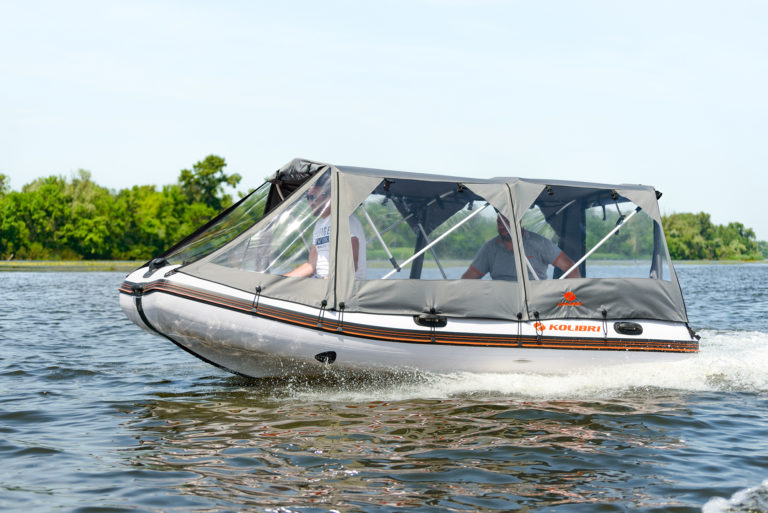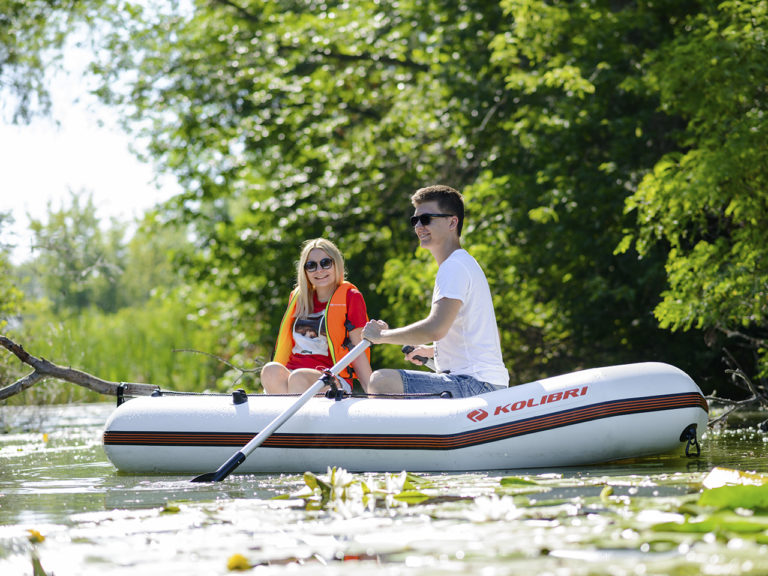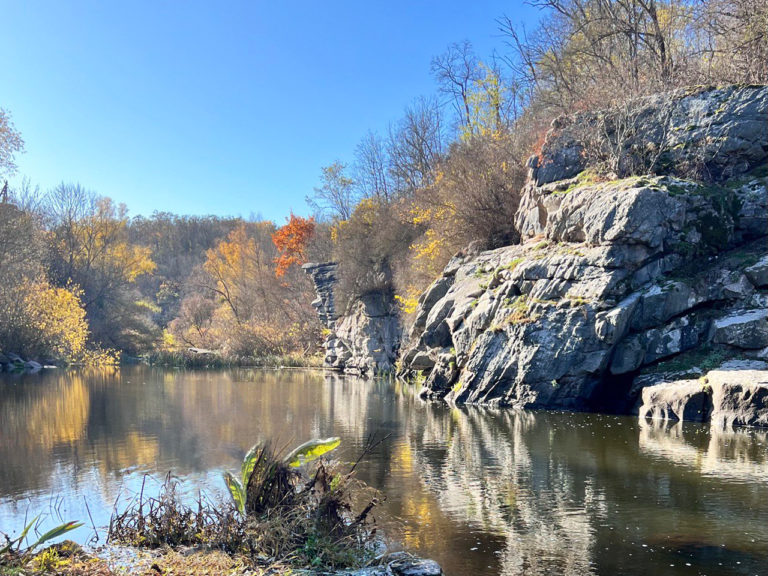Inflatable boat in the planing mode

A glisseur (from French “glisser” – to glide) is a light high-speed watercraft. Planing is mode of operation of a watercraft on water, when an object is held on the surface due to the high-speed water pressure, that is, slides along the water surface. When entering the planing mode, there is a sharp decrease in the resistance to movement due to the smaller area of the hull which is located in the water. The speed increases sharply. Take, for example, a windsurfing board – it completely comes out of the water, stops pushing it apart with its hull and begins to slide, accelerating rapidly. This is a good example of switching to the planing mode. A thrown stone, jumping on the surface of the water, also planes.
So, planing mode (of an inflatable boat) is the movement when a watercraft goes at a certain speed, at which its hull is submerged in water by the stern part by about one third. In order to get your boat to plane, a number of factors must be observed, and we will discuss them in this article.
Possible modes of a boat operation
There are three modes of boat operation — displacement, semi-displacement (plowing) and planing modes:
- Displacement mode
This is when you move at a speed of up to 15 km/h – when the boat is slowing down, when accelerating or moving by means of oars. The area of the wetted surface of the hull is maximum. In this mode of operation, the watercraft creates a high wave. The mode is typical for boats with a low-power engine.
- Semi-displacement (plowing) mode
The boat moves with a strongly raised bow. This mode of operation can be reached at speeds of 16-18 km/h.
- Planing mode
In this mode, the speed of the watercraft is from 20 km/h and more. The surface of the water touch is minimal (approximately ⅓ of the body in the water). The boat is in a more horizontal position compared to the semi-displacement mode of operation. Planing mode is the most economical mode of boat operation. This driving mode is characterized by a decrease in power while maintaining the maximum speed. It happens due to the fact that the force required to switch to planing mode significantly exceeds the force required to maintain it. With equal fuel consumption in the planing mode, you can cover a much longer distance.
What does it mean to enter the planing mode
There are two known ways of moving on water: by means of the Archimedes force (or the buoyant force) and hydrodynamics. The Archimedes principle is a law which explains the pushing action on any body immersed in a liquid or gaseous medium. When any watercraft (canoe, boat, or huge vessel) enters the water, it displaces a certain amount of liquid. And when this watercraft begins to move, it must overcome the resistance of a kind of water pocket. But as soon as the boat can accelerate and get to planing mode, this resistance drops to almost zero.
You can get a PVC boat with an outboard motor to plane when you reach a certain speed. To determine the maximum possible planing speed for a particular watercraft, the Froude formula is usually used.
Fr= V/√(gL),
where,
V — speed of a watercraft;
g — acceleration of free fall;
L — length of a watercraft hull.
As a rule, for displacement watercrafts, the Froude number varies in the range of 0.2 – 0.3, and for boats that can plane, the number exceeds 1.
But again, everything is pretty conditional here. And this formula, in any case, works well for solid-hulled watercrafts. But as for small inflatable boats, everything is much simpler here. Almost any inflatable boat with an outboard motor with the power of 3 hp and above is able to get into the planing mode under favorable conditions. And, as a rule, it happens at the speed of 18 – 21 km/h.
Types of planing boats
A PVC boat is hard to get to plane, it is almost impossible or dangerous to enter the planing mode using old boats, in shallow water or with a low-power motor. While planing, the bottom of the boat is exposed to a significant load, and at high speed, random objects in the water can damage the hull.
Planing can be done on relatively light keel boats with a strong enough bottom and a powerful engine. To do so, it’s better to go into open water. The hull of the boat should be as streamlined as possible, the center of gravity is better to be shifted closer to the bow. Of course, a PVC boat is designed to be strong and have a minimum of protruding parts that can affect aero and hydrodynamics.
A PVC boat won’t plane out: what are the reasons
If a PVC boat cannot get on plane, there may be several reasons.
As mentioned above, first of all, i could be a low speed, which depends on a number of factors:
- insufficient engine power;
- insufficient ratio of engine power to the curb weight of the boat (ratio should be 1 hp to 25 kg of weight);
- incorrect engine mounting angle on the transom (should be 5-15 degrees);
- incorrect distribution of the cargo/passengers weight inside the boat (the center of gravity should be shifted forward);
- wrong shape of the boat hull.
What characteristics should an inflatable PVC boat have for perfect planing? Is there a universal way to get your boat to plane? Is it possible to buy a boat that can operate in planing mode without any alterations, special tricks or additional efforts?
Indeed, the Ukrainian KOLIBRI Boat Manufacturing Company have been producing such boats for a long time — those are several different series of inflatable PVC keel boat models designed for use with motors from 5 to 35 hp.
For example, boats of the Light, Profi, SL or XL series are perfect for planing. They have a streamlined body with an optimal ratio of size, load capacity and motor power. We especially want to highlight the KM-360DSL model.
This is our most favorite boat model. It is large and capacious enough, at the same time harmonic and graceful. In planing mode, the KM-360DSL goes almost with no splashes and leaves a clean wake.
Please also pay attention to our other models, their detailed description and technical characteristics can be found on our website.
Inflatable Boat with Motor: The Perfect Blend of Speed and Versatility
In the realm of watercraft, inflatable boats have carved out a unique niche. Their lightweight, portable, and versatile nature has made them a favorite among water enthusiasts. Adding a motor to an inflatable boat takes this versatility to the next level, creating a powerful and nimble vessel that’s perfect for a variety of waterborne activities.
Inflatable Boat Speed: Power on the Water
One of the standout features of inflatable boats with motors is their impressive speed. Unlike traditional paddle or rowing-powered inflatables, adding an outboard motor significantly enhances your boat’s velocity. The speed achievable depends on various factors, including the boat’s size, the motor’s horsepower, and the load it carries.
For smaller inflatable dinghies equipped with a modest outboard motor, you can expect speeds in the range of 10 to 20 miles per hour. These nimble craft are perfect for leisurely cruises, fishing expeditions, or quick trips to your favorite water spots.
As you scale up to larger inflatable boats with more powerful outboard motors, the speed capabilities increase dramatically. Some inflatable speed boats can reach speeds of 40 miles per hour or more. These boats are designed for thrill-seekers and water sports enthusiasts, offering an exhilarating ride over the waves.
Boat Planing: The Key to Speed
To truly unlock the speed potential of an inflatable boat, it’s essential to understand the concept of planing. Planing is a mode of operation where the boat skims across the water’s surface rather than plowing through it. In this state, the boat’s hull rides on the water, minimizing drag and allowing for higher speeds.
Inflatable boats are capable of planing, provided they meet certain criteria. To achieve planing, you typically need:
- Sufficient Engine Power: Your outboard motor should have enough horsepower to generate the thrust required for planing.
- Proper Weight Distribution: Balancing the weight of passengers and cargo inside the boat is crucial. The center of gravity should be shifted towards the bow to help the boat achieve a level, planing position.
- Aerodynamic and Hydrodynamic Design: Inflatable boats designed for planing often have streamlined hulls and minimal protruding parts to reduce air and water resistance.
Inflatable Boat with Outboard Motor: A Winning Combination
The marriage of inflatable boats and outboard motors creates a winning combination. Here’s why these boats are a favorite among water enthusiasts:
- Versatility: Inflatable boats with motors are incredibly versatile. They can be used for fishing, exploring, water sports, transportation, or simply cruising. Their adaptability makes them suitable for various activities.
- Portability: When deflated, inflatable boats are easy to transport and store. This portability allows you to explore different water bodies and launch from various locations.
- Safety: Outboard motors provide a reliable means of propulsion, reducing the risk of getting stranded on the water due to changing currents or winds.
- Ease of Use: Operating an outboard motor is relatively straightforward, even for beginners. This user-friendly aspect makes inflatable boats with motors accessible to a wide range of people.
- Economical: Inflatable boats are generally more affordable than traditional hard-shell boats. They also tend to be more fuel-efficient, providing cost-effective water adventures.
- Low Maintenance: Outboard motors are known for their low maintenance requirements, making them a hassle-free option for boat enthusiasts.
Inflatable Dinghy with Outboard Motor: Compact Powerhouse
If you’re looking for a compact yet powerful watercraft, consider an inflatable dinghy with an outboard motor. These smaller boats are perfect for solo explorations, fishing trips, or quick rides across the water. They combine the convenience of an inflatable with the added speed and maneuverability of a motorized engine.
Inflatable Speed Boat: For Thrill-Seekers
For those who crave speed and excitement on the water, inflatable speed boats are an ideal choice. These boats are designed for maximum velocity and agility, making them perfect for water sports, racing, or simply experiencing the thrill of high-speed cruising.
In summary, inflatable boats with motors offer an exciting blend of speed and versatility. Whether you prefer leisurely outings on the water or heart-pounding adventures, these boats can be customized to meet your needs. With the right combination of boat size, motor power, and design, you can enjoy the best of both worlds – the convenience of an inflatable and the exhilaration of speed on the water. So, get ready to embark on unforgettable aquatic journeys with your inflatable boat and engine.







